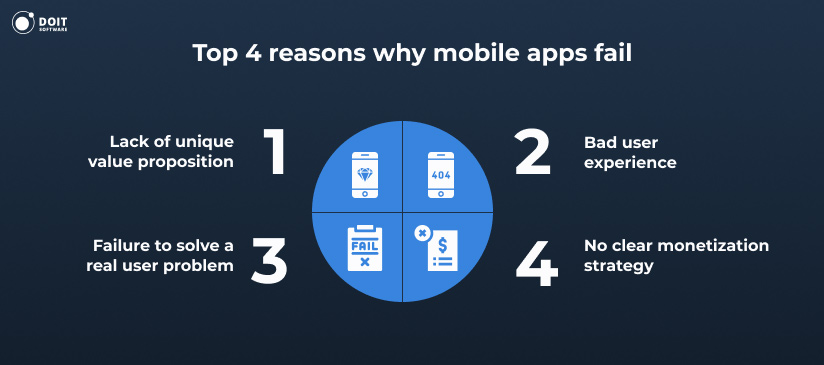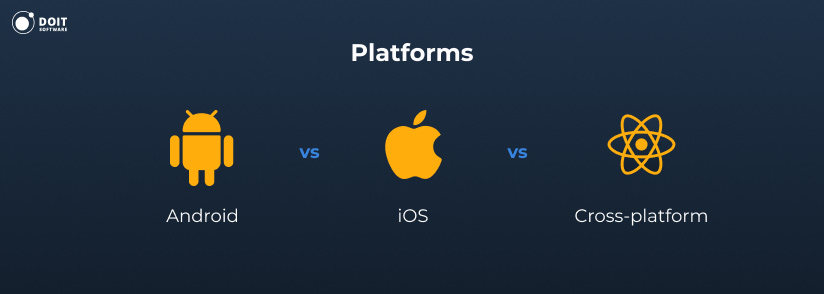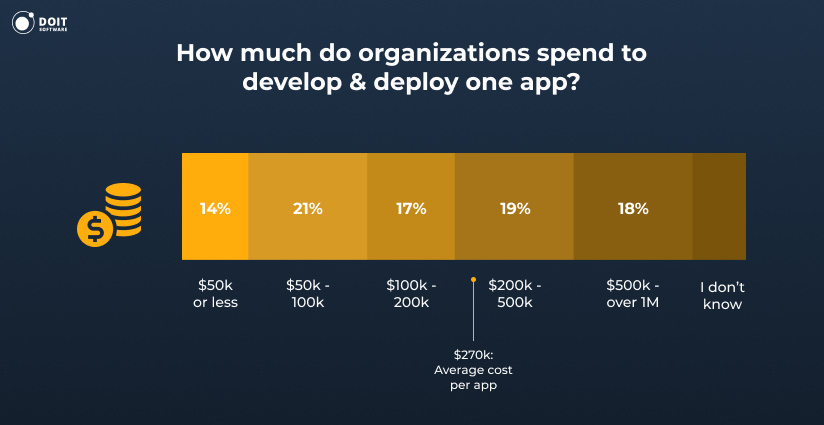After hitting the $581.9 billion mark in revenue in 2020, according to Statista, the worldwide mobile applications revenue in 2023 is going to reach a new milestone – $935.2 billion. It is no surprise that more and more SMEs and startups turn to top mobile app developers to build an application that will help them reach new potential customers.

So what is mobile app development? It is a set of processes and activities involved in writing software for mobile devices. In other words, mobile app building embodies developing applications for a whole range of devices: tablets, smart watches, phones and any other portable device. Even web developers have to think about the mobile availability of their systems and make sure that their web pages look good on mobile devices.
The difficulties start when you try to utilize all the features modern smartphones are equipped with, such as near-field communication, GPS, Bluetooth, and cameras. These features open up new opportunities for mobile app developers, and at the same time make app development much more complicated. In this competitive market, the best app developers are forced to fit all the features into the less powerful hardware of mobile devices to make sure they have a chance against web applications.
What other difficulties might you face during mobile app development and how to make this process more effective?
Even though the market of mobile app development is growing larger and larger, generating tons of revenue for companies and reaching new customers, at least 80% of applications do fail. Why is it so and how to maximize your chances for success?

Considering the complications and the chance for failure, why should you get into mobile app development? What are the benefits of phone application development that override the negatives?

How can an application generate additional revenue streams for your business? First of all, customers can purchase your product or service using the app instead of going to a store. Secondly, a company can earn extra income on the side by promoting other products and generating an advertising revenue stream. Additionally, if your app is good enough, you can sell subscriptions or extra services. Finally, you can sell non-personal identifiable user data to data collectors.

An application can act as a call center and also technical support if you integrate chats or at least provide basic information. Instead of calling your company to ask a question about your product, your customers will be able to collect some of the information right in your app. This option boosts user experience and acts as a more cost-friendly way of customer support than having an in-house team.

Traditional marketing strategies are great but require a decent investment. By installing push notifications on your application, you can use them as a way to promote a new product or event.

Using your application, users can share their thoughts via surveys and other feedback options. Mobile applications help you get closer to your customers and form a better bond with them.
Now you understand the importance of building an application. But where do you even start? How do you draw a mobile app development project plan and choose the appropriate technology? Here is a short guide on mobile app development.
Before diving into the technical side of the question, let’s identify your mobile app development strategy, objectives, and monetization model.
There are four basic steps to building a mobile application:
UVP should be concise, clear, and easy-to-understand. What unique value will your application bring to your customers? Which problem is it going to solve?
2. Set the goals and performance standards
Define goals for your application that fall in line with your business decisions. For example, you might want to unlock new revenue streams or improve customer satisfaction.
On top of that, set clear performance standards and KPIs that will help you to measure the success of your application – load speed, crash reports, retention rate, and others.

Who is your target user and which of their problems are you trying to solve? What do they value in an application and what are their needs and pain points?
Using too much information and trying to solve too many problems in one solution is never a great idea. Users will get overwhelmed and confused by the complexity and navigation and features, and will abandon your tool.
Your mobile application will be handling and storing a lot of data, including sensitive customer information. When it comes to security, your reputation is at stake since exposing customer data might lead to very serious consequences. Decide how you will protect your company’s and users’ data. Mobile app consent is essential to ensure users are informed and have control over their data privacy.
Now the data is safe and secure, but what are you going to do with it? How will you leverage the large amounts of information to better enhance your business?
You can use the collected data to gain insights into the market, establish behavioral patterns, engage with the audience and promote new products, etc.
Monetization is a way of translating an asset into a revenue stream. If the generated revenue does not exceed the spending, your application is not successful and will go bankrupt. On the other hand, if new clients bring in larger value than the amount of expenses you used to acquire them, your business will benefit greatly.
There is a plethora of monetization options for a mobile application, including advertising, affiliate marketing, and lead generation. If you’re also focused on driving larger sales pipelines or managing complex transactions, collaborating with a development agency can help create an integrated platform that scales your mobile app’s revenue strategy and aligns it with your goals. But before jumping into B2B ecommerce development you need to prepare software requirements specifications. Let’s discuss it in more detail.
After defining your goals and strategies, it is time to establish the main features and tech stack for your project, and prepare a Software Requirements Specifications document (SRS document). A SRS document is something you can show to your stakeholders to quickly have them understand your application idea. It contains a comprehensive description of the goals, strategies, technologies, features, and so on. However, before creating the SRS document, you should consider drawing a mind map. Using a mind map creator can greatly facilitate this process. This tools allow you to visualize your thoughts and ideas, making it easier to identify connections and relationships between different elements of your project. They provide an organized structure for information collected from brainstorming sessions, facilitating the transition into drafting the SRS document.
What is mind mapping and how does it impact the success of your SRS document? In short, mind mapping is a process of visual organization and representation of large amounts of various information. First, set up a brainstorming session to collect the information:
Besides listing features, determine the costs, time, and scope of each function. This way, in case you have tight deadlines, your mobile app developers will be able to prioritize the features and eliminate less important non-functional ones.
The second part is called: general system description. You will find a detailed description of each section you find in the template. In short, mention if the application is new or already existing and name its primary interfaces and structural elements. Then, go over the modes and states of the system, describe assumptions and dependencies.
The third part covers the system’s capabilities, conditions and constraints. In other words, this part revolves around a detailed description of technical requirements such as database, frontend and backend technology, integration with third-party systems, cross-platform availability, and scalability options.
Part number four goes over the system interfaces. Here is where you explain the dependencies between system components. Make sure to describe all four types of interfaces: user, hardware and software, communications.
The fifth part of the SRS document is called “Requirements traceability matrix” (RTM). It is here to make sure that every requirement will undergo testing and ensure a smooth development process. RTM is a necessity because it connects requirements to tests and guarantees that every requirement will be covered by a test case. For example, proper color distinctions can make or break your app’s usability. Leveraging a HEX code finder during testing is crucial in maintaining design consistency by allowing for the accurate selection of colors.
The remaining parts of the SRS are self-explanatory: references, glossary, revision history, and appendices.

Before we choose the right technology for mobile app development, we need to establish the platform. Should you build for iOS or Android or maybe both?
Depending on the platform of your choice, now you can start thinking about the right tech stack for your mobile app development.

Stable performance
More expensive than cross-platform
Long app lifetime
Time-consuming
More scalability and flexibility of applications
More updates are required
Fully compliant with the platform
Easy to learn
Smart extension functions to build APIs
Large open-source ecosystem
Solves Java’s nullability problem
Apps are lighter
Low-cost adoption
Faster development process than Kotlin
Concise and allows for fewer errors
Flexible coding environment with Dynamic Tapping
Allows for error-free coding and fewer bugs
Compatibility with C++ and C codes
High performance and fast speed
Has been tested and tried for many years
Automatic Reference Counting automatically track memory usage
Fewer developers required for the building
Lower performance
Less expensive
Release of new features take longer
Development process is shorter
Harder code design
Reusable code
The most popular language for cross-platform app development is JavaScript. Paired up with one of the most prominent mobile app development frameworks, React Native, you can develop mobile apps that feel and interact like native on Android and iOS.
React Native has revolutionized cross-platform mobile app development by enabling you to use the same UI building blocks as native apps. Alternatively, you can use TypeScript to build mobile applications. It offers a quick error detection feature and provides a higher level of security.
Flutter is a framework that allows you to develop applications for both iOS and Android using the same source code. You can build native-like apps with the combination of the Dart language and Flutter.
Since Flutter is a mobile only cross-platform framework, you can focus on exclusively mobile features without keeping web functions in mind. Flutter is known for its fast development and native-like applications.
Apache Cordova is a great choice for building simple mobile apps quickly and efficiently. It allows you to use web technologies (HTML, CSS, and JavaScript) to create cross-platform solutions.
This framework enables developers to turn web-based projects into mobile applications by wrapping them in a native container. This way, the apps can access device features like the camera and GPS.
If your in-house team lacks some knowledge and skills for iOS or Android mobile app development, consider collaborating with a technical partner. But how do you choose an appropriate mobile apps company that will understand your needs? How can one get an app development company to fully understand their experience and readily bring you the best results?
First of all, start with yourself and make sure you know what you need. Define the goals of the application and your expectations. On top of that, choose the platform you will be building for and create a list of requirements.
Next, prepare a set of questions to recognize the company’s fitness for your business culture and also their level of experience.
Finally, do thorough research and gather the information about the mobile app development agency:
We have talked about prototyping earlier, but what about MVP or Proof of Concept? What is the difference between them and what benefits do they bring?

First of all, it is important to mention that PoC, prototype and MVP are not the same thing. They are different methods of testing your idea and are created for different purposes.
PoC checks whether the application can be built. Developers test technical assumptions to see whether the application with these particular functionalities and features can be created. If you can’t decide if your project requires a PoC, here are three main clues that will help you make the right decision:
Prototype shows how the application or feature can be built. Being sort of a draft of the future application, a prototype allows you to feel the product and visualize it. It is a quick and affordable way to test the product and gain first valuable feedback.
As a way of prototyping, you can simply draft a paper prototype or draw one on a whiteboard. Another method is a low-fidelity interactive prototype whereby you apply the paper version and build a wireframe. For this, you can use a prototyping tool to focus on design, colors, and images. Finally, you can proceed with a high-fidelity prototype that implies building the full UI and assessing it using a testable interface. This the closest you can get to the real thing with prototyping.
MVP or minimum viable product is the small version of the end product that incorporates the most essential features. MVP is a basic type of a product that will help you evaluate user experience and its ability to meet your business goals.
As a part of MVP strategy, you will generate assumptions together with your team, and then test them. You can look for inspiration in your competitors’ applications, but keep in mind that you will have to do better than them.
Building an MVP becomes significantly more important when you are building a different UI. On top of that, MVP is a vital part of agile methodology where you release a new product after every iteration thus shortening time-to-market.
User-orientation
No
Yes
Yes
Technical orientation
Yes
No
Yes
Facilitates the investment
Partially
Partially
Yes
Business value
Testing the core features
User feedback
Real market feedback
Cost
Medium
Low
High
There is no right answer here as it depends on a multitude of various factors. The size of the application, how well you plan it, the number of bugs you will need to fix, the duration of the project, etc., – all of these aspects will impact the overall cost of mobile application development.

How high is the app development cost? Let’s take a closer look at the costs of developing famous applications:
WhatsApp’s basic features include registration, contacts, notifications, chats, geolocation, and video calling. All of the above collectively take up roughly 800 to 900 hours to develop. Remaining duties like UX/UI design, project management and quality assurance will take another 400 to 500 hours. As a result, the application will be built in 1,200 to 1,400 hours. The cost of an hour depends on the county: in the US the rate is roughly $120, in the UK – $60, in Eastern Europe – $35 to $45. Thus, app design and development in the US will cost you somewhat between $144,000 and $168,000 and in Eastern Europe only from $42,000 to $63,000.
What if you want to make an Uber-like application? The client-side functions here are registration, booking, payments, card information, tracking, notifications, and ride history. This part application will take about 500 hours to complete. Additionally, count the driver-side features like reply to request and booking history – 300 hours – and admin dashboard together with UX/UI design – 250 hours. Collectively, the Uber-like app takes 1,050 hours to build and will cost $126,000 in the US and $36,750 to $47,250 in Eastern Europe.
We have already made the cost comparison above. This large discrepancy is the reason for the trend for outsourcing work to Eastern Europe and Asia. The cost of living in those countries is much lower which makes their app development rates more affordable. Besides saving you money, outsourcing also gives you access to a larger pool of talent. Finally, you can simply delegate the entire mobile application development process to an iOS and Android app development agency and concentrate on your business goals.
Proof of Concept, prototyping, and, most importantly, MVP are the key to your success. MVP makes the app designing process significantly more effective by reducing the anxiety of under developing. Top app developers will not get distracted by excess features and only concentrate on the functional ones to launch an MVP. On top of that, by releasing small products each cycle, you have a higher chance of detecting bugs and fixing them immediately.
In other words, without testing the technical feasibility of your ideas, getting first user feedback, and learning from your mistakes, you have no chance in this competitive market.
Mobile apps can be easy targets for cyber attacks. Don’t be so ignorant as to think your app is impenetrable. Many mobile app security tools (MAST) accompany your app from development to after it’s live. DataDomes article on mobile app security tools has an in-depth list of apps for you to consider. They are easy to install, don’t disturb the architecture, and work almost autonomously.
Offer your customers real-time protection as part of their journey with you. Circumvent bugging, stalling, malware, and information theft. Create a better, safer user experience with your app.
After you release the application, your work is not done. First of all, keep track of major input metrics like funnel analytics, social sharing, user behavior, user demographics, and others. All this data will help you evaluate the success of your application and adjust it to meet users’ needs.
Secondly, the mobile application market is incredibly competitive which is why the need for innovation is very important. You need to come up with new features and functionalities, test and implement them, as well as collect user feedback. This is a continuous process due to market saturation and changing platform guidelines.
Finally, market your application to reach your target audience and achieve the business goals. If you don’t promote your product, it will inevitably get lost in the ocean of applications on the market.
DOIT Software is a mobile app development company with years of experience in iOS and Android phone application development. Having supported many businesses with enterprise mobile app development, we have first-hand knowledge of the best technologies that will help with your business goals. We will walk you through the discovery phase and build a new application from scratch or update the existing one.
Since we also offer staff augmentation, we have the best mobile app developers on our staff who can solve any technical issues. If you are looking to extend your team for a duration of the project, we can offer you our mobile app developers for hire to fill in the necessary skill gaps. Contact our team of top-notch specialists and launch the first small product – MVP – in less than 2-3 months.
Transform your idea into a successful product with the DOIT Software team.
Contact usEasier maintenance and upgrades, security of business information, smoother integration with third-party applications, generation of additional revenue streams.
For cross-platform development, we use React Native, Flutter.
Don’t skip the discovery phase and build PoC, prototypes and/or MVPs. Also, do not underestimate the role of the project manager, who will take care of cost, duration and scope estimation, tech staffing, quality assurance, and delivery.
Depending on the complexity of the application, it may vary from $20,000 to $50,000.










